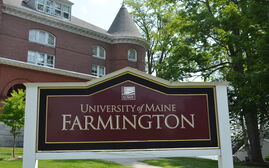
Processing Your Payment
Please do not leave this page until complete. This can take a few moments.
Farm-to-table pioneer helps Saint Joseph's College grow Maine's food economy
 Photo / James McCarthy
Mary Paine, chef for Saint Joseph's College's summerlong series of Farm-to-Table Dinners at The Stone Barn, prepares a platter of hors d'ouevres for guests at the Aug. 2 dinner.
Photo / James McCarthy
Mary Paine, chef for Saint Joseph's College's summerlong series of Farm-to-Table Dinners at The Stone Barn, prepares a platter of hors d'ouevres for guests at the Aug. 2 dinner.
Farm by farm, chef Mary Paine creates her menu. It’s the favorite part of her job creating the summerlong series of Farm-to-Table dinners at Saint Joseph’s College’s historic Stone Barn that can accommodate up to 250 guests in its dining hall and courtyard.
“I get provisions from the whole state,” she said. “I get to pick what’s in season and I do that every week. I feel very lucky to be at the Stone Barn. I get to go to anyone I want. I love that.”
For the college’s Aug. 2 Farm-to-Table dinner, Paine selected Maine Family Farms for the chicken and Pearson’s Town Farm in Standish for the ground lamb that became the main entree of chicken roulade and lamb chorizo. She picked Saco River Farms in Standish for goat cheese, herbs and produce, and Snell’s Family Farm in Buxton for sun-gold tomatoes, garlic scapes and blackberries.
By Thursday, her list of providers extended from Skowhegan and Norridgewock to Old Orchard and Standish.
In addition to the paying guests, the Aug. 2 dinner featured a number of the farmers invited to join the feast by Paine. She’d been given a handful of complimentary tickets by Peter Nielsen, executive director of Saint Joseph’s mission-aligned business initiatives, to invite anyone she wished as honorary guests.
For Paine that was an easy assignment.
“Our goal is not only to spotlight the Stone Barn as a venue but also the local farmers,” she said. “My view is that the important people at those tables are the farmers. The whole menu is built around them. To me that’s the best part of the whole dinner series. Some of the farmers don’t even know I’m using their produce until I give them a call.”
This year’s farm series ended last Thursday; its featured dinner of lobster was sold out, as was the previous week’s featuring pork. The $100-per-person fee includes a six-course dinner, all beverages (specialty cocktails, wine, after-dinner drink, local brews, and non-alcoholic beverages) and gratuity.
A focal point for Saint Joseph's food initiatives

Nielsen says the college hired him a little more than two years ago as entrepreneur-in-residence and then, at the start of this year, gave him the additional role of serving as executive director of its mission-aligned business initiatives.
It’s a threefold role. He’s tasked with developing social enterprises that further the college’s educational mission and develop sustainable revenue streams while also addressing critical regional and state needs.
The Stone Barn — an early 20th century Normandy-style structure that’s situated in the middle of an 18-acre farm at the center of the college’s 474-acre campus — is a focal point of the college’s local food system efforts, he says. It underwent a $1 million renovation through an investment from the college’s endowment and is now generating revenues as a multipurpose venue for weddings, corporate events, seminars and special events such as the summer series of weekly Farm-to-Table dinners.
The college’s farm will include sheep and goats, livestock that Nielsen said are increasing in importance due to Maine’s growing immigrant populations who prefer those meats. “The demand for sheep and goat has gone up considerably the last decade,” he says. “It’s a great opportunity to diversify our agricultural products and enterprises away from beef.”
Institute for Local Food Systems Innovation

The farm dinners are part of the college’s ambitious and far-reaching efforts to support the year-round production of fresh local food in Maine as well as provide “a well-trained generation of food entrepreneurs to build the industry that will support it," Nielsen said.
Launched almost a year ago, the college’s $4 million Institute for Local Food Systems Innovation is funded by a $1.9 million federal EDA grant, a $500,000 gift from the Hannaford Charitable Foundation and donations from several private foundations and individuals. The funding will enable the college to start construction of a quarter acre hydroponic greenhouse this fall, as well as develop a 3,400-square-foot commercial kitchen and a livestock barn, among other elements.
Agritourism offerings, which are overseen by Victoria Amaro, include the farm-to-table dinners, tours of local farms, field trips for local public schools and farm volunteering.
Another $3 million will be invested eventually, making the college’s Institute for Local Food Systems Innovation an overall $7 million initiative.
Nielsen said a preliminary economic impact analysis by 45 North Research projects the institute would provide a total net gain of $16.1 million in output for the Sebago Lake Region’s economy, including $4.1 million in earnings and 135 jobs during its construction and operation.
Its biggest long-term impact, he added, will be the food incubator, which will help home-based food enterprises scale up their operations. “As we build an entrepreneurial culture it will help those food business grow and have an impact on food system innovation.”
Mark Green, a professor of natural science at Saint Joseph’s, is the founding program director of the institute. Its mission, he said, is to build a sustainable base for Maine’s food sector.
The hydroponic greenhouse, with construction slated to begin this fall, is occupying a good bit of his attention right now.
His oceanographic work has is what got him involved in sustainable, locally sourced food — both as a researcher and as an oyster farmer and owner of Basket Island Oyster Co., which has been growing mussels, oysters and scallops for more than 10 years in Casco Bay.
Maine is well-positioned to be at the forefront of the local food movement, both traditional agriculture and the new developments in aquaculture and hydroponics, he says. It has lots of clean freshwater and its cold ocean saltwater is the perfect growing medium for shellfish.
“It’s all about what are alternative ways to grow food and how to do it in a concentrated area,” Green says of the college’s hydroponics project. “It’s all wrapped around the idea of what’s sustainable and what is not.”
Meet the farmers

As guests settled into their places at the two long tables within The Stone Barn’s post-and-beam dining area, Paine held up the menu for that evening’s six-course dinner. Eighteen Maine farms, breweries, distilleries, vintners and grain suppliers were listed, along with their contribution to that evening’s menu.
“If your name is on the list, please stand up,” she said with joy in her voice as seven diners stood beside their places at the two tables. “You are a part of this. Every week you are a part of this. We don’t use anything else but local produce as we put together these Stone Barn dinners.”
A quick glance at those standing offered an encouraging counterpoint to recent news stories telling how nearly one-third of Maine’s farms and farmland are expected to change hands in the next decade, as more Maine farmers begin to reach retirement age and grapple with what to do with their farms.
Most of those standing were clearly young, and eager to share their stories with nearby diners.
“It’s not only our livelihood, it’s what we love to do,” said Alaina Robbins, a partner in the Old Wells Farm in Limington with Dylan Watters, his brother Stowe and Marina Steller.
Their farm’s contribution to that evening’s dinner was a “harvest of carrots,” which found their way into Paine’s entree as “maple-glazed baby carrots” to go with chicken roulade, lamb chorizo, manchego and saffron almond rice.
Waters says he and his older brother grew up on the farm and decided about six years ago to make a go of it as a MOFGA-certified organic farm growing greens, tomatoes, beans, beets, carrots, peppers and squash, root vegetables, potatoes and winter squash, and ending with roots, potatoes, winter squash. They also raise organic pork and seasonal flowers that are sold via their flower Community Supported Agriculture program that provides weekly bouquets for 10 weeks.
“It used to be cattle,” Dylan Watters says of the 30-acre property that has two acres devoted to organic farming. “Stowe and I said we should give it a go and see if we can turn the land where we grew up into our livelihood, and at the same time serve our community.”
Watters says the farm sells its produce, pork and flowers through its Community Supported Agriculture programs, in which members pay a seasonal fee in order to receive weekly shares of freshly picked food items when they’re in season. They also sell at the farmers’ market in Gorham.
“You see people come back every week,” said Robbins. “They’re in a good mood. They’re enthusiastic. People still want to come out and have that personal connection when they’re buying from us.”
Watters says the phone call from Paine “came out of the blue.” She wondered if they might have some baby carrots for her planned entree dish. They did and they delivered. She also invited them to join that week’s dinner at St. Joseph’s Stone Barn.
“It’s an opportunity for us,” Robbins said, noting that other than their website, Old Wells Farm doesn’t have a budget for advertising.
“We really want to see local foods served in restaurants as much as possible,” Watters says. “That’s why we’re growing it. We want people to have access to food that’s local.”
A farm-to-table pioneer

Paine brings years of working in restaurants to her role as chef of the Farm-to-Table Dinners at Saint Joseph’s Stone Barn.
Her journey to the kitchens at Saint Joseph’s includes stints at the Good Egg and Pepperclub in Portland in the 1980s and 1990s and, more recently, at the Nebo Lodge on North Haven. She brings an artist’s eye to each dinner, choosing foods that not only will be tasty together but also be visually appealing.
One example: Serving lemon-scented carrots with their greenery still attached on the large platter she created for the pre-dinner hors d'oeuvres featuring local cheeses (smoked ricotta, manchega and gouda), custom-made crackers and rice crackers.
“You can eat the greens,” she said of the carrots on that platter. “It’s a pretty sharp flavor. I love serving carrots that way. It gives people the feeling they’ve just come out of the earth. People love seeing that: Seeing the vegetable in its whole form.”
She credits Saint Joseph's President Jim Dlugos, now in his sixth year leading the college, as being a driving force behind the college’s initiatives to build a stronger local food economy in Maine.
“It’s his vision,” she said, adding that the opportunity to be part of those efforts — and having the incredible setting of the Stone Barn to showcase her culinary creations during the summer series of Farm-to-Table dinners — has been “really remarkable.”
“It all came together for me,” she said of her role as the college’s assistant director of food services. “There’s less traveling involved. I’m closer to home.”
She also appreciates the opportunity it’s giving her to work with college students who might have an interest in cooking or other aspects of the hospitality industry.
Her only disappointment in the Aug. 2 Farm-to-Table dinner, Paine said is that the rice served in the main course wasn’t from Maine.
“Where’s the rice from? It came from way far away,” she said.
But her tone of disappointment was quickly followed by an enthusiastic memo-to-self statement that conveys without necessarily meaning to the sense of mission behind those weekly dinners.
“There is a rice-maker in the state growing rice,” she said of Maine’s only commercial rice farm, Wild Folk Farm in Benton. “I have to find out a way to get some of their rice. I’m a Mainer. I like my carbs.”














Comments